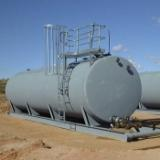Diesel Fuel Algae Treatment
Figuring out that you have algae in your fuel is one thing. But getting rid of it and keeping it away is a whole other ball game. A game you've got...
The last decade, since 2014 when the complete transition of all off-road diesel fuel to ULSD was completed, has seen a dramatic rise across the nation in incidents of fuel storage tanks contaminated with "algae". We put that in quotes because we know it's not really "algae", but rather, other fuel microbes like mold, fungus, and bacteria. It's commonly called algae because that's what people think it is (it's not really algae because algae is a microscopic plant organism, plants need light to grow, and fuel tanks are too dark to give them the light they need), so we roll with it. Whether it's really algae or it's bacteria or fungus, the problems are the same, no matter what you call it.
Problems are the subject of the day today: how to recognize if you've got an algae/microbe problem in your fuel tank.
There's a mountain of evidence and information that tells us what contributes to diesel fuel algae contaminating a tank. Much of it comes from ULSD's change in fuel composition - fewer aromatic and less sulfur, more biodiesel content across the board. This has all resulted in diesel fuel that microbes love to grow in.
How do you know if you've got a diesel fuel algae problem? Consider these warning signs that may point to a problem.
1. You stick the fuel tank and find any significant depth of water phase. Just as little as a quarter-inch layer of water at the bottom is plenty enough for microbes and diesel fuel algae to grow and thrive. And remember, depending on the size of the storage tank, just a quarter inch can represent tens of gallons of water in that tank.
2. You go through filters at a faster rate than normal. Diesel fuel algae plugs filters like crazy because the microbial bodies themselves get caught, as well as the black, slimy biomass matrix that they produce over the course of their lifecycle(s). Filters are also plugged when the activity of the microbes causes the fuel itself to lose storage quality and break down at a faster rate. The microbes will also make biomass in the tank which can easily plug filters. Any abnormal increase in filter plugging rate is a warning sign to check the tank for microbes.
3. You run a microbe test and it comes back positive. This kind of testing is the third prong of the Hybrid Approach to Fuel Care. There are different kinds of in-field microbe tests you can get. The best kind to use is an ATP test. We generally don't recommend culture tests for this kind of application. They are cheap but there's a reason why that is. They're not very accurate and overly prone to both false positives and false negatives.
Once you've confirmed you have an active microbe problem, you can take the next step to clearing the problem up.
Figuring out that you have algae in your fuel is one thing. But getting rid of it and keeping it away is a whole other ball game. A game you've got...
When considering diesel fuel contamination by microbes, 'the devil is in the details'.

For generators and diesel storage tanks fungus, mold, and bacteria pose a serious threat because they can clog fuel filters and decrease efficiency. ...